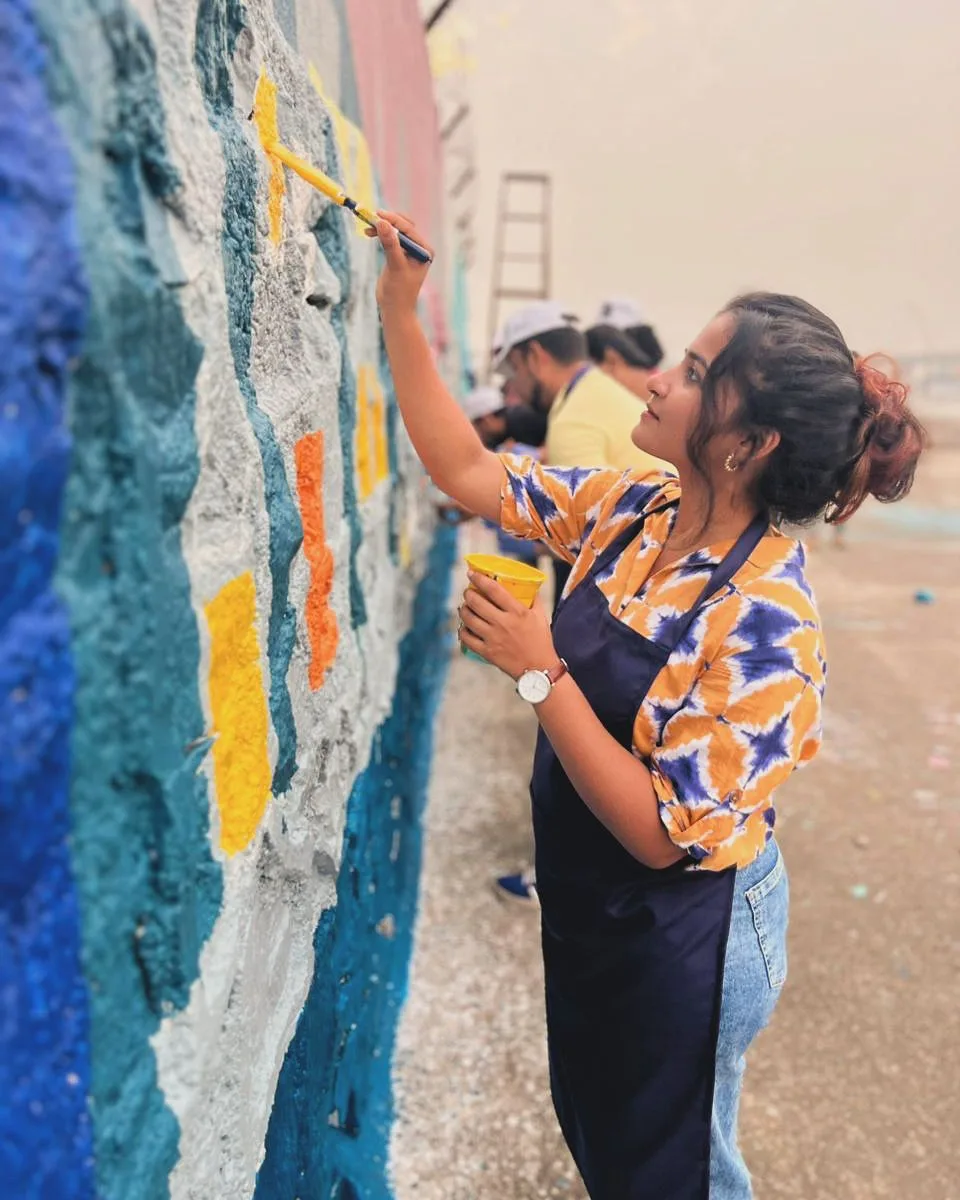Welcome to our exclusive interview series, Young Professionals in Heritage, where we delve into the vibrant world of young heritage professionals. This series shines a spotlight on the dynamic individuals who are shaping the future of the heritage sector.
Our guest this week is Lakshmi R. Lakshmi is a conservation architect, who specialises in urban and rural regeneration projects. She is actively engaged in heritage advocacy and sustainable transformation of cultural and heritage precincts.
We, young professionals, need to actively come together in creating awareness of the same amongst the common people and the future generations to protect our heritage that is being lost every single day.
Let’s start with simple questions – What does a conservation architect do? And how does the conservation of architecture fit in cities like Mumbai, Chennai, Bangalore, etc where there is rampant redevelopment?
The role of a conservation architect predominantly lies in the restoration of built heritage. In that process, they are involved in extensive documentation of the building through measured drawings, condition assessment (mapping of defects, damage patterns, structural conditions), and providing solutions for uplifting the life of the building through structural, non-structural solutions along with design interventions for better spatial organization, etc. A building can undergo conservation and continue the same usage or find an adaptive usage. For example, an abandoned building can be restored/conserved to become a heritage hotel, resort, museum, or any other apt use based on stakeholder requirements.
However, the role of a conservation architect is diverse and you will find them involved at city and rural levels in urban regeneration projects, archaeological projects, historical research, cultural curation for museum projects and exhibitions relating to heritage, interpretation projects like signages, publications; operations and management for tourism apart from built heritage conservation.
Recent discussions on conservation emphasise that development and conservation can go hand in hand when done with a sensitive, context, and people-centred approach. Hence, in cities like Mumbai, Chennai, Bangalore, etc. conservation has a far reach compared to smaller cities and towns in India where there is a lack of awareness of the distinct heritage that they possess owing to loss of heritage.
In my opinion, creative capacity-building programs to educate the locals and utilizing government schemes to conserve the heritage of value is the need of the hour. The same should be focused on small towns/cities shifting focus from the most concentrated cities/parts of cities.
Conservation of built heritage is multifaceted and no two projects will have the same approach and solution. However, can you tell us if there are certain challenges a conservation architect faces that are perhaps common to most projects?
Yes, I believe it is true for any project not just conservation. Ideally, no two projects should have the same approach considering the fact that solutions need to be context-based to ensure its longevity and sustenance. Hence, the challenges vary from project to project. However, a common challenge faced through conservation projects in my experience is the difficulties in bridging together all stakeholders in executing the project within the timeline with certain decisions and strategies that need regular addressing based on site needs. Another challenge is finding the right skilled craftsperson to work with specific traditional materials. India needs to learn from global case studies and conduct capacity-building programs. One interesting example is Malaysia (Georgetown, Penang) where capacity building for training labourers by skilled craftspersons is done regularly ensuring the skills are transferred from generation to generation.
Does a conservation architect only work with built heritage or do they also work with green spaces and natural heritage around built heritage? Do you think it is high time the natural heritage of cities should be factored in while making heritage and urban development policies for cities and towns?
As I mentioned before, conservation architects work on varied typologies of projects in cultural heritage. Conservation architects engage in city /urban scale projects that look beyond the built heritage, where the concepts of identity, circular economy, and intangible heritage like traditional arts, crafts and practices are integrated with people-centric approaches. Many cultural heritage projects factor in the encompassing green spaces, and natural heritage through the initiative. There are schemes and policies that exists, however, the major gap lies in the lack of integration or a common roof to look at the existing guidelines. These loopholes pave the way for insensitive development. Such abrupt construction in cities needs immediate attention and containment. In my opinion, integrated policies at various levels- national, regional and local will hopefully bring about a change to the scenario.
You have worked at the grassroots level with the people. Can you tell us if public participation played a major role in transforming heritage or cultural precincts? Do you think public participation is necessary for such transformation projects?
Community involvement is vital in urban transformation and regeneration projects. Stakeholder round table discussions are held for many projects inviting opinions from all stakeholders. Such practices help in the smooth happening of projects and development keeping all stakeholders informed in good capacities.
One of the projects, I was part of last year involved creating self-help groups (SHGs) focused on cloud kitchen service with selected women of the community. The project was initially funded by the CSR of the organisation (RPG Foundation) and later meant to be a self-sustaining model in itself. The process involved conducting various meetings, and training with experts on topics beyond cooking dealing with hygiene, quality, and safety standards amongst others. This project was part of a larger initiative to transform the cultural heritage of the area. Such projects within larger initiatives combined contribute to the circular economy and uplift the livelihoods of the people.

I definitely believe public participation is crucial in driving impactful projects. A need and context-based integrated approach can ensure in achieving meaningful ground interventions. There might be situations that require discussions and negotiations to arrive at meaningful causes and fruitful interventions for development for all stakeholders. Hence, it is crucial to have regular meetings and discussions to ensure the holistic development or transformation of a cultural landscape or place.
A common notion about the conservation of built heritage is that it is an expensive affair. Do you think this plays a major role in choosing redevelopment over conservation or adaptive reuse of the building?
Yes, it is presumed that the conservation process is expensive when compared to new construction. It is important to call for discussions with the stakeholders in creating awareness of the benefits of conservation over fast-paced redevelopment leading to loss of architectural, and associative values. While I agree that conservation could be more expensive than new construction, however, it is important to understand the long-standing benefits conservation can offer being longevity, less carbon footprint unlike demolition, and good microclimate amongst many others. In addition, it is important to understand that the house/property
can be modified to suit current needs.
My partner and I are working on restoring an ancestral home in rural Maharashtra, where certain spaces of the house do not have relevance in the present. We are transforming them to fit the current needs and aspirations of the client. Similarly, the entire house is taking a new life with its roots laid in the past by the process of restoration. We are glad the client has been understanding amidst repetitive pressure from his friends to go for demolition and build a new house.
This acceptance of the need for conservation comes with proper awareness. India is far behind in awareness when compared to the treasure trove of heritage it has. We, young professionals, need to actively come together in creating awareness of the same amongst the common people and the future generations to protect our heritage that is being lost every single day.
A few years ago the Hall of Nations was demolished and rebuilt as Bharat Mandapam. Of course, as a modernist structure, it came with a fair bit of maintenance and upkeep challenges. As a conservation architect do you think adaptive reuse of architecture can save such iconic buildings? What do you think is the biggest merit of this practice?
I believe with the technological advancements in the field, a lot is possible. Hence, any building can be structurally restored, conserved and provided an adaptive reuse based on the needs. Conservation is very much like a doctor’s treatment. The building undergoes diagnosis, tests, and treatment and continues to live. The process is the same for urban sites as well and that is why the term regeneration is used in giving life to urban spaces.
While adaptive reuse is one strategy, many other strategies can be looked at for saving heritage buildings. Say using it as a façade for projecting meaningful urban messages if the building is at a strategic location. New creative strategies to save heritage need to be worked out and implemented. The biggest merit of this practice is its ability to provide life to something that is in ruin, or undergoing deterioration. Certain buildings that we work with also form part of the city’s memories, or a public space thus creating meaningful impact.

